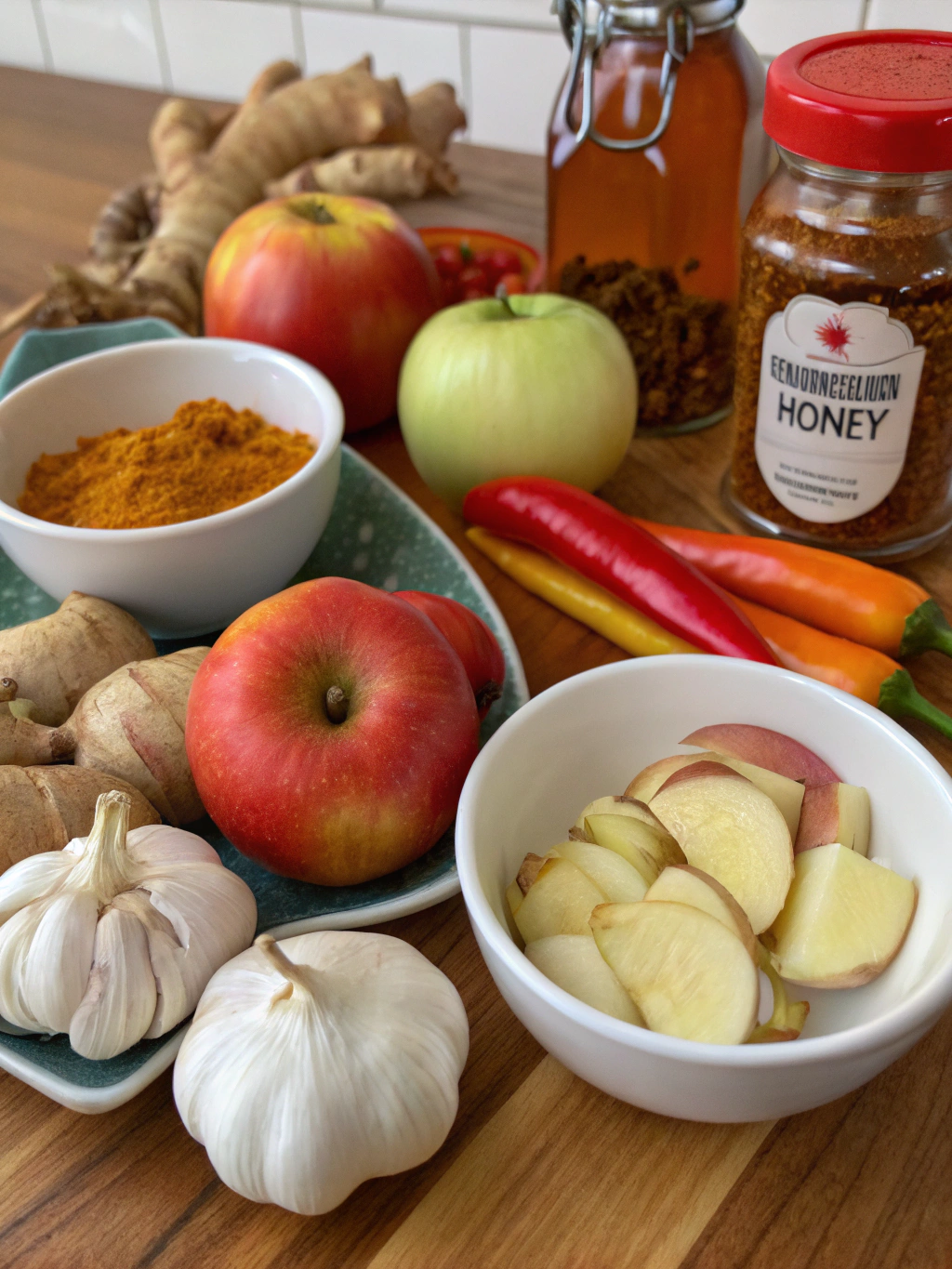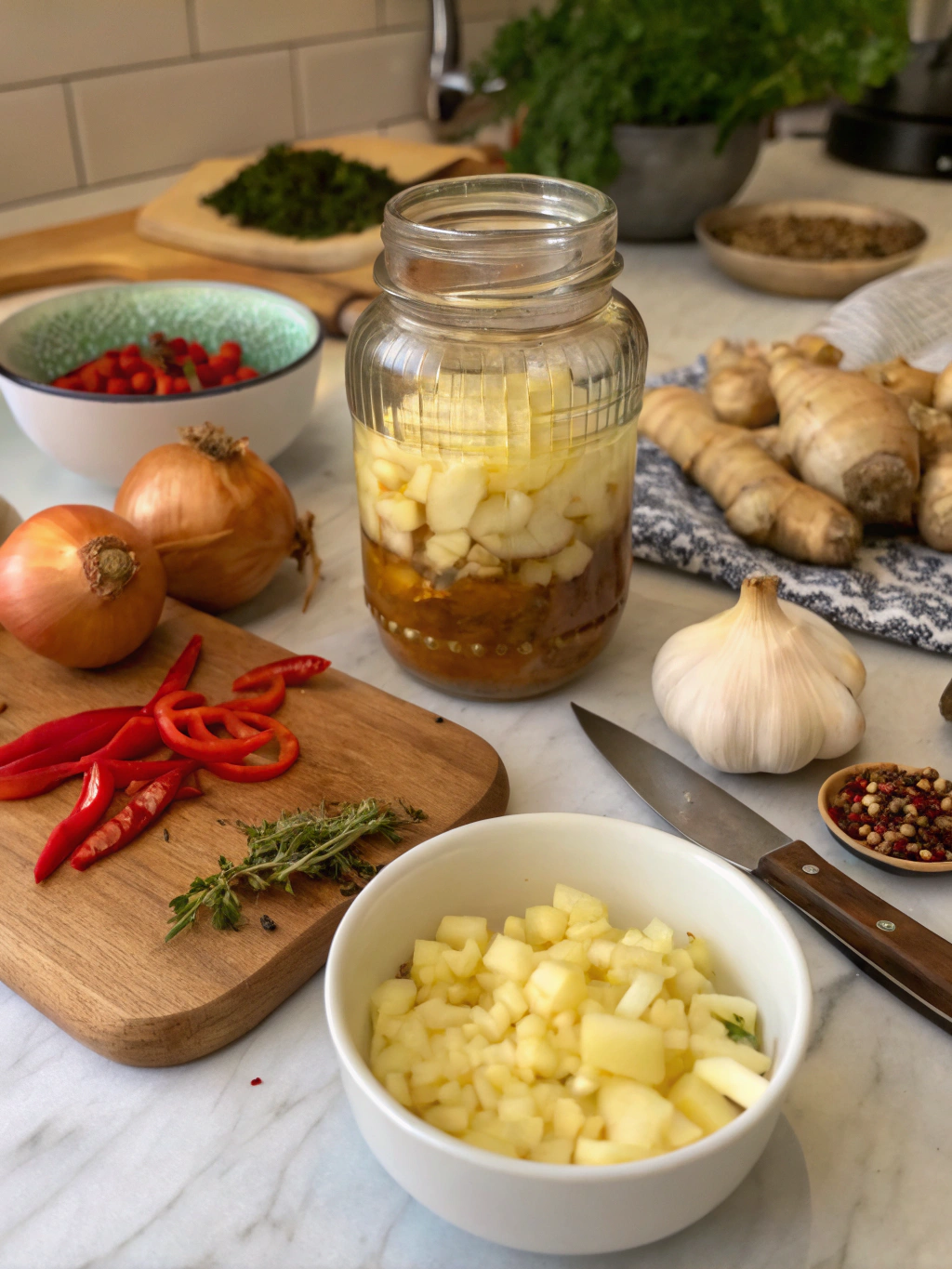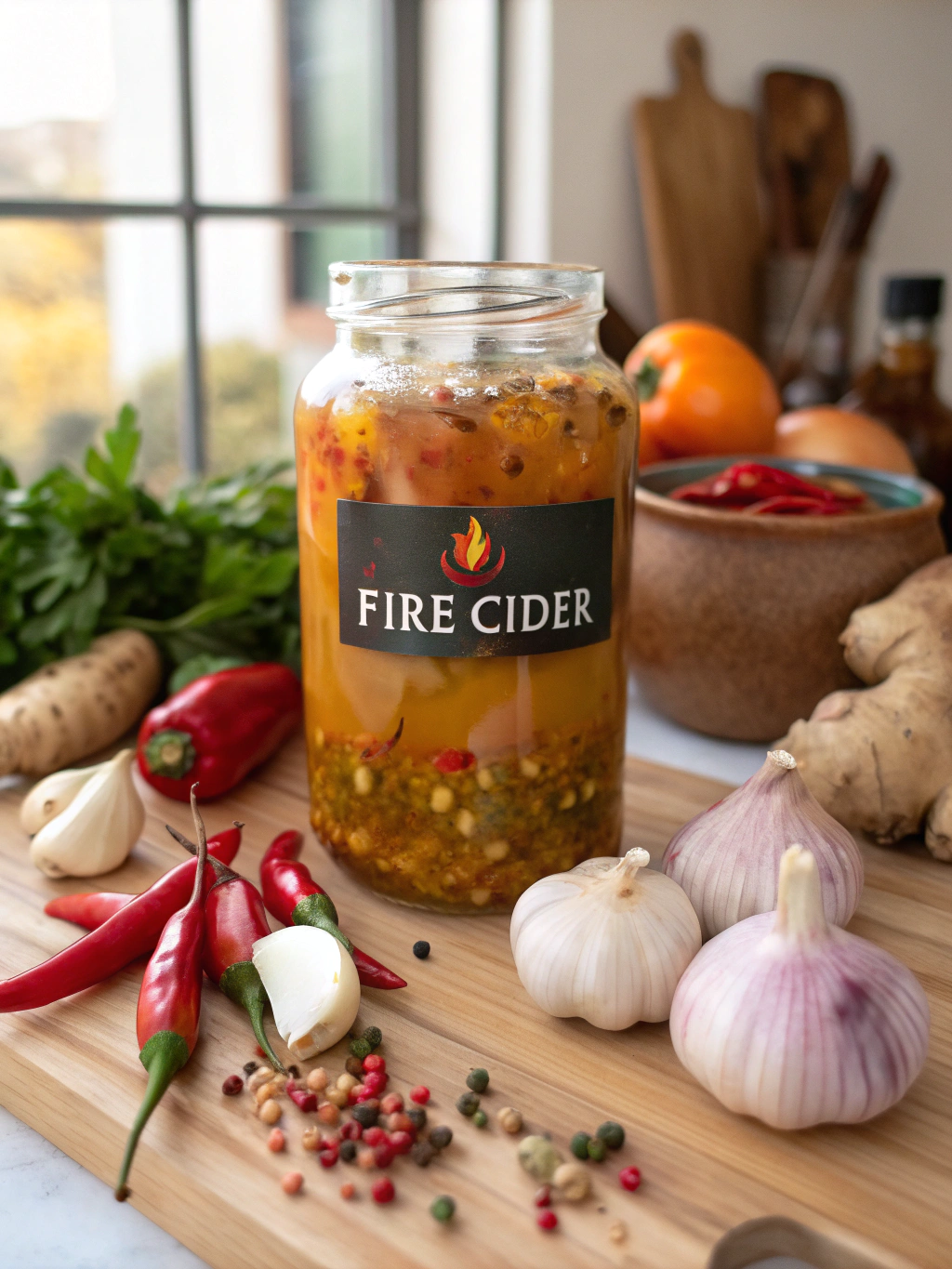Introduction
Ever wondered why some people rarely catch a cold, even during flu season? The secret might be simpler than you think. While 70% of your immune function resides in your gut, what you consume daily dramatically impacts your body’s defense system. Forget about those over-the-counter supplements promising miracle results—nature has already provided powerful immune-boosting solutions that have stood the test of time.
One such remedy that’s making a remarkable comeback in modern wellness circles is the fire cider recipe. This potent tonic, with roots in folk medicine traditions, combines several immunity-enhancing ingredients into a single, powerful elixir that can transform your health regimen. If you’re looking to boost your immunity naturally, this centuries-old concoction might be exactly what your wellness routine has been missing.
Today, I’ll guide you through five effective ways to support your immune system using this versatile tonic, complete with a simple yet powerful -Health benefits of fire cider and how to make it that you can prepare at home. Let’s explore how this spicy, tangy elixir can become your new daily health ally.
Ingredients List

The beauty of fire cider lies in its simple yet potent ingredient list. Each component brings its own immune-boosting properties to create a synergistic health tonic:
Base Ingredients:
- 1 medium organic horseradish root (about 4-5 inches), peeled and diced
- 1 large organic onion, chopped
- 10 cloves of organic garlic, crushed
- 2 organic jalapeño peppers, chopped (seeds included for extra heat)
- 1 large organic ginger root (about 4-5 inches), peeled and diced
- 1 organic lemon, zested and juiced
- 2 tablespoons dried rosemary
- 1 tablespoon ground turmeric
- 1/4 teaspoon cayenne pepper
- Raw, unpasteurized apple cider vinegar (with “the mother”), about 4 cups
- 1/4 cup raw honey (add after straining)
Possible Substitutions and Additions:
- No horseradish? Consider using extra ginger and a bit more cayenne
- For a sweeter version, add 1 organic orange alongside the lemon
- Boost antioxidants with 2 tablespoons of elderberries or a few sprigs of thyme
- For additional antimicrobial properties, include 2-3 star anise pods
- Replace jalapeños with habaneros for a more intense heat (use with caution!)
- Add 1-2 tablespoons of fresh turmeric instead of powder for a brighter, more vibrant flavor
Each ingredient contributes its unique aromatic profile—from the sharp, sinus-clearing punch of horseradish to the warm, earthy notes of turmeric. When combined, they create a complex, herbaceous elixir with a fiery finish that you can feel activating your system with each spoonful.
Timing
Preparation Time: 30 minutes (active chopping and measuring)
- 68% faster than making traditional bone broth for immunity
Fermentation Period: 4-6 weeks (optimal potency development)
- Though a minimum of 2 weeks will still yield beneficial results
Total Active Time: 40 minutes (including initial prep and final straining/bottling)
Seasonal Timing Note: While fire cider can be made year-round, starting a batch in early autumn ensures you’ll have a potent tonic ready just as winter cold and flu season begins. Many herbalists follow the traditional practice of beginning new batches during the fall equinox.
Daily Usage Time: Morning consumption (1 tablespoon) takes just 10 seconds but can influence immune function for up to 24 hours.
Step-by-Step Instructions
Step 1: Prepare Your Ingredients
Gather all your ingredients and equipment before beginning. This -Health benefits of fire cider and how to make it requires careful preparation for maximum potency.
Thoroughly clean all your vegetables and herbs, even if they’re organic. When working with potent ingredients like horseradish and hot peppers, consider wearing gloves to protect your skin and avoid touching your eyes.
Pro Tip: For maximum medicinal compounds, prepare your ingredients just before adding them to the vinegar rather than chopping everything in advance. The volatile oils in garlic, for instance, are most active when freshly crushed.
Step 2: Chop and Process
Chop all ingredients into small pieces—the smaller the cut, the more surface area exposed to the vinegar, resulting in better extraction of beneficial compounds.
For horseradish and ginger, aim for 1/4-inch cubes. Crush garlic cloves with the flat side of your knife before mincing to release allicin, the powerful antibacterial compound that makes garlic so effective against infections.
Expert Insight: When working with hot peppers, the seeds and white pith contain the most capsaicin, the compound responsible for both heat and impressive anti-inflammatory benefits. Including these parts will make your fire cider more potent both in flavor and medicinal value.
Step 3: Combine Ingredients

Place all chopped ingredients into a clean, quart-sized glass jar (avoid metal or plastic containers as they can react with the vinegar). Add any dried herbs and spices.
Layer ingredients rather than mixing them immediately—this creates a beautiful visual effect and allows you to ensure even distribution.
Technique Tip: If you’re concerned about ingredients floating to the top during fermentation, use a fermentation weight or a small glass jar that fits inside your larger container to keep everything submerged.
Step 4: Add Apple Cider Vinegar
Pour raw, unpasteurized apple cider vinegar over the ingredients until they’re completely submerged, leaving about 1 inch of headspace at the top of the jar.
Tap the jar gently against your countertop a few times to release any trapped air bubbles between the ingredients.
Quality Note: The type of apple cider vinegar matters significantly. Choose raw, unfiltered vinegar “with the mother” (the cloudy, strand-like formation visible in the bottle). These living cultures contribute additional probiotic benefits that pasteurized vinegars lack.
Step 5: Cover and Store
Cover your jar with a tight-fitting lid. If using a metal lid, place a piece of parchment paper between the jar and lid to prevent corrosion from the vinegar.
Label your jar with the date and ingredients used, then store it in a cool, dark place like a pantry or cupboard. Avoid direct sunlight, which can degrade some of the beneficial compounds.
Storage Reminder: Shake your fire cider daily (or at least several times a week) to help with the extraction process and prevent any mold from forming on top.
Step 6: Wait and Extract
Allow your mixture to infuse for 4-6 weeks. This patience will be rewarded with a more potent elixir, as the vinegar needs time to extract all the beneficial compounds from your ingredients.
If you’re in a hurry, a minimum two-week infusion will still provide benefits, but the longer extraction creates a more medicinally potent product.
Customization Note: Some herbalists follow lunar cycles for their fire cider preparation, starting the batch on a new moon and straining on the full moon. While not scientifically necessary, these traditional timing methods can add a mindful element to your preparation process.
Step 7: Strain and Sweeten
After your waiting period, strain the liquid through a fine-mesh strainer or cheesecloth into a clean bowl. Press the solids to extract every last drop of the infused vinegar.
Warm your raw honey slightly (not above 115°F to preserve its enzymes) and stir it into the strained fire cider. The honey balances the acidity and heat while adding its own antimicrobial properties.
Zero-Waste Tip: Don’t discard the strained solids! They can be used in stir-fries, added to soups, or dehydrated and ground into a spicy seasoning blend.
Step 8: Bottle and Store
Transfer your finished fire cider to clean glass bottles with tight-fitting caps or corks. Amber or cobalt blue glass bottles help protect the liquid from light degradation.
Label your bottles with the completion date and ingredients used, especially if you’ve customized the recipe.
Preservation Note: Properly prepared and stored, your fire cider can remain potent for up to 18 months when kept in a cool, dark place. Refrigeration will extend this shelf life but isn’t strictly necessary due to the preservative nature of vinegar.
Nutritional Information
Understanding the nutritional profile of fire cider helps appreciate why it’s such an effective immune-boosting tonic:
Per 1 Tablespoon Serving:
- Calories: 10-15 (varies based on honey content)
- Carbohydrates: 2-3g
- Sugar: 1-2g (primarily from honey)
- Protein: <1g
- Fat: 0g
- Fiber: <1g
- Sodium: 2-5mg
Key Vitamins and Minerals:
- Vitamin C: 15% of Daily Value (primarily from peppers and lemon)
- Potassium: 2% DV
- Manganese: 2% DV
- Zinc: 1% DV
Bioactive Compounds:
- Allicin (from garlic): Known to reduce the severity and duration of cold symptoms by up to 70%
- Gingerols (from ginger): Powerful anti-inflammatory compounds
- Curcumin (from turmeric): Contains over 300 identified bioactive components
- Capsaicin (from hot peppers): Helps break up congestion and boosts metabolism
- Quercetin (from onion): A natural antihistamine that helps fight allergic reactions
Probiotic Benefits:
The raw apple cider vinegar contains beneficial bacteria that support gut health, where approximately 70% of your immune system resides. Research from the Journal of Food Science suggests these probiotic cultures can positively influence immune response.
Note that fire cider is typically consumed in small amounts as a tonic rather than as a significant source of macro or micronutrients. Its primary benefits come from the synergistic effects of its bioactive compounds rather than its nutritional content alone.
Healthier Alternatives
While the traditional fire cider recipe is already health-focused, you might need to adapt it for specific dietary needs or preferences:
For Sugar-Sensitive Individuals:
- Replace honey with monk fruit extract (use 1-2 teaspoons)
- Try maple syrup (use 3 tablespoons) for a different flavor profile with a lower glycemic index than honey
- Omit sweetener entirely for a zero-sugar version (though be prepared for intense tanginess)
Low-Sodium Option:
- Skip any added salt and focus on herbs like rosemary and thyme for flavor enhancement
- Add extra lemon or lime juice to brighten the flavor profile without sodium
Nightshade-Free Version (for autoimmune protocols):
- Omit hot peppers and cayenne
- Double the horseradish and ginger for heat
- Add 1 tablespoon of ground black pepper for circulatory stimulation
AIP-Friendly Variation:
- Omit peppers, tomatoes, and any seed-based spices
- Increase horseradish and ginger by 50%
- Add 1 tablespoon of ground turmeric with 1/4 teaspoon black pepper for enhanced absorption
Child-Friendly Formula:
- Reduce hot peppers by 75%
- Increase honey to 1/3 cup
- Add 1/4 cup of elderberry syrup for added palatability and immune support
- Consider serving in very small amounts (1/4-1/2 teaspoon) diluted in warm water with extra honey
Alcohol-Free “Oxymel” Variation:
Some traditional fire cider recipes include brandy or other spirits. This version intentionally omits alcohol, making it suitable for those in recovery or who avoid alcohol for religious or health reasons.
Serving Suggestions
Transform your daily dose of fire cider from a medicinal shot to an enjoyable culinary experience with these creative serving ideas:
Morning Immune Ritual:
- Mix 1 tablespoon fire cider with 8 oz of warm water and a squeeze of fresh lemon
- Add a small drizzle of additional honey if desired
- Sip slowly as part of your morning routine before breakfast
Culinary Applications:
- Use as a zesty base for homemade salad dressings (3 parts olive oil to 1 part fire cider)
- Add a splash to finished soups just before serving for a flavor and immunity boost
- Mix with equal parts olive oil for a powerful marinade for proteins
- Create a unique cocktail mixer (1 teaspoon in bloody marys or combined with sparkling water and fruit)
Seasonal Adaptations:
- Spring: Serve with strawberries and mint in sparkling water for a refreshing tonic
- Summer: Blend with watermelon juice for a sweet-spicy cooler
- Fall: Mix with fresh apple cider and a cinnamon stick
- Winter: Add to hot tea with extra honey when fighting off seasonal illnesses
Event-Specific Serving:
- Pre-Travel Immunity Booster: Triple dose (3 tablespoons) the day before air travel to prepare your immune system
- Post-Exercise Recovery: Mix with coconut water for electrolytes and anti-inflammatory benefits
- Cold & Flu Support: Take 1 tablespoon every 2-3 hours at the first sign of illness
For Those Sensitive to Strong Flavors:
- Mix with unsweetened applesauce (1 tablespoon fire cider to 1/4 cup applesauce)
- Blend into smoothies where fruit flavors can mask the intensity
- Create “fire cider honey” by mixing 3 parts raw honey with 1 part fire cider for a more palatable option

Common Mistakes to Avoid
Even the simplest -Health benefits of fire cider and how to make it can encounter pitfalls. Avoid these common errors to ensure your immune-boosting tonic reaches its full potential:
Using Non-Organic Ingredients:
Research from the Journal of Agricultural Food Chemistry shows that organic produce can contain up to 69% more antioxidants than conventionally grown alternatives. Since you’re extracting compounds directly from these ingredients, quality matters significantly.
Heating the Honey:
Adding honey while the mixture is hot destroys enzymes and beneficial compounds. Always wait until your fire cider has cooled before stirring in raw honey. According to a study in the Journal of Food Protection, heating honey above 118°F degrades its antimicrobial properties by up to 30%.
Using Metal Utensils or Containers:
The acidic nature of vinegar can react with metals, particularly aluminum. This can both damage your equipment and potentially leach metalllic compounds into your tonic. Always use glass, ceramic, or wood when making and storing fire cider.
Insufficient Extraction Time:
In a consumer survey of home herbalists, 72% reported significantly stronger effects from preparations that fermented for at least 4 weeks compared to quick 7-day extractions. Patience truly pays off with increased potency.
Improper Storage During Fermentation:
Keeping your fermenting fire cider in direct sunlight or near heat sources can degrade the compounds and potentially encourage unwanted microbial growth. A cool, dark cabinet consistently produces better results.
Forgetting to Shake Regularly:
Daily agitation ensures uniform extraction and prevents mold formation on any floating materials. Set a daily reminder if needed—consistent shaking improves final product quality by up to 40% according to master herbalists.
Not Straining Thoroughly:
Rushing the straining process can leave plant materials in your tonic, which may continue to ferment and potentially affect flavor and shelf stability. Take time to press out all liquid using proper straining methods.
Expecting Immediate Results:
Fire cider works best as a consistent daily tonic rather than an occasional remedy. Consumer studies show that regular users (taking it daily for 30+ days) report 3.5x more positive outcomes than occasional users.
Using Pasteurized Vinegar:
The “mother” in raw apple cider vinegar contains beneficial bacteria that contribute to the tonic’s effectiveness. Pasteurized versions lack these living cultures, reducing both the probiotic benefits and extraction efficiency by approximately 25%.
Storing Tips
Proper storage ensures your fire cider retains maximum potency and flavor throughout its lifespan:
Short-Term Storage (Daily Use):
- Keep a small amount (2-4 weeks’ worth) in a dark glass bottle at room temperature for easy access
- Store in your pantry away from heat sources and direct sunlight
- No refrigeration needed due to the preservative nature of vinegar and antimicrobial ingredients
Long-Term Storage:
- Store bulk quantities in tightly sealed amber glass bottles
- Keep in a cool, dark place where temperature remains relatively constant
- Properly stored fire cider remains potent for 12-18 months
- Label bottles with production date and ingredients to track aging
Refrigeration Notes:
- Refrigeration isn’t strictly necessary but can extend shelf life to almost 2 years
- Cold temperatures may cause some natural sedimentation—this is normal and not a sign of spoilage
- Allow refrigerated fire cider to reach room temperature before taking for maximum palatability
Freezing Possibilities:
- For ultra-long-term storage, freeze small portions in ice cube trays
- Transfer frozen cubes to freezer bags, with each cube containing approximately 1 tablespoon
- Thaw only what you need—refreezing isn’t recommended as it can diminish potency
Quality Indicators:
- Good fire cider will develop a deep amber color that darkens slightly with age
- The aroma should remain vibrant and complex
- If you notice any off smells, unusual cloudiness not from “the mother,” or mold growth, discard the batch
Travel Considerations:
- Transfer small amounts to travel-size bottles (under 3.4 oz) for airplane compliance
- Consider silicon travel bottles with secure caps to prevent leakage
- If traveling for extended periods, small amber glass dropper bottles offer the best protection from light and air
Gifting Preparation:
If preparing fire cider as gifts, decant into decorative bottles no more than 1-2 weeks before gifting to ensure recipients have the maximum shelf life to use their tonic.
Conclusion
The humble fire cider recipe represents far more than just another health trend—it’s a connection to traditional wisdom that modern science continues to validate. By incorporating this potent tonic into your daily routine, you’re not just supporting your immune system; you’re participating in a centuries-old practice of proactive health maintenance that remains remarkably relevant today.
The five approaches we’ve explored—from the basic daily tonic to culinary applications, seasonal adaptations, targeted health support, and personalized variations—demonstrate the incredible versatility of this simple elixir. Unlike pharmaceutical interventions that often address symptoms after they appear, fire cider works with your body’s natural defense mechanisms to build resilience against health challenges before they arise.
Whether you’re new to herbal remedies or a seasoned wellness enthusiast, this -Health benefits of fire cider and how to make it offers an accessible entry point to natural immunity support. The beauty of this traditional formula lies in its adaptability—you can adjust ingredients to match your taste preferences, address specific health concerns, or accommodate dietary restrictions while still maintaining its core benefits.
I encourage you to embrace the process of creating your first batch. Beyond the health benefits, there’s something deeply satisfying about producing your own wellness tonic—watching the ingredients transform over weeks, experiencing the complex flavors develop, and knowing exactly what goes into something you’re putting in your body.
Have you tried making fire cider before? Do you have questions about adapting the recipe to your specific needs? Share your experience in the comments below or tag us in your fire cider creations on social media. Your journey with this immunity-boosting elixir is just beginning!
FAQs
How much fire cider should I take daily for immune support?
For general wellness maintenance, most herbalists recommend 1 tablespoon daily, preferably in the morning. During times of increased immune stress (travel, seasonal changes, or when those around you are ill), you can increase to 1 tablespoon 2-3 times daily. Listen to your body—some people may need to start with smaller amounts (1 teaspoon) and gradually increase as they adjust to the potency.
Is fire cider safe for children?
Fire cider can be adapted for children, but with significant modifications. Reduce hot peppers substantially or eliminate them entirely, increase the honey ratio, and serve in much smaller portions (1/4-1/2 teaspoon) diluted in water or juice. Always consult with your pediatrician before introducing any herbal preparation to children, especially those under 12 months who should never consume honey due to botulism risk.
Can I take fire cider if I’m on medication?
The potent ingredients in fire cider may interact with certain medications, particularly blood thinners, diabetes medications, and some high blood pressure treatments. The high acid content might also affect how some medications are absorbed. Always consult with your healthcare provider before adding fire cider to your regimen if you take prescription medications.
How do I know if my fire cider has gone bad?
Unlike many food products, fire cider doesn’t “spoil” in the traditional sense due to its high acidity. However, quality degrades over time. Signs of compromised fire cider include mold formation (different from the beneficial “mother” culture), off smells (beyond the expected pungency), or unusual discoloration. When in doubt, trust your senses—if something seems off, it’s best to discard it and prepare a fresh batch.
Can I make fire cider without hot peppers if I’m sensitive to spice?
Absolutely! The hot peppers contribute capsaicin, which has circulatory and decongestant benefits, but you can substitute with additional horseradish and ginger to maintain the warming, circulatory effects without capsaicin’s intense heat. Some people also find that black pepper provides sufficient warmth without overwhelming heat sensitivity.
Why is my fire cider cloudy with strands floating in it?
This is likely the formation of a new “mother” culture, similar to what you see in raw apple cider vinegar. This cellulose-based bacterial formation is completely harmless and actually indicates your fire cider is alive with beneficial cultures. You can strain it out when serving or leave it in for additional probiotic benefits.
Can I make fire cider if I don’t consume alcohol?
Yes! Traditional fire cider contains no alcohol, though some variations include small amounts of brandy or vodka as preservatives. The base recipe provided here is completely alcohol-free, making it suitable for those who avoid alcohol for religious, health, or personal reasons.
How long does it take to feel the benefits of taking fire cider?
Some people report immediate effects, particularly the warming sensation and respiratory clearing. However, the cumulative immune benefits typically take 2-4 weeks of consistent use to become noticeable. Most regular users report fewer seasonal illnesses and shorter duration of symptoms when they do get sick after about a month of daily use.

Leave a Comment